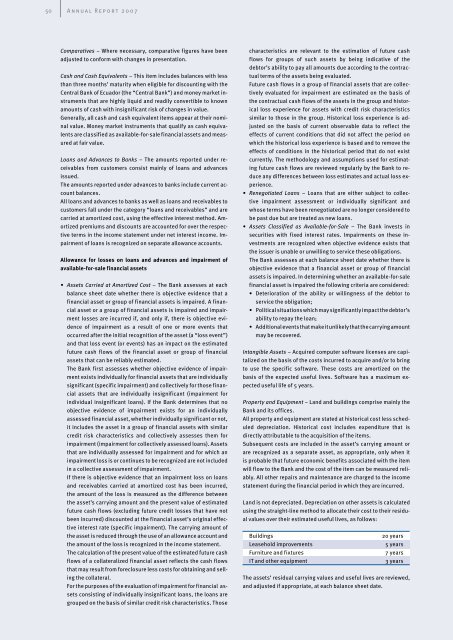Annual Report 2007
Annual Report 2007
Annual Report 2007
You also want an ePaper? Increase the reach of your titles
YUMPU automatically turns print PDFs into web optimized ePapers that Google loves.
0<br />
A n n u a l R e p o r t 2 0 0 7<br />
Comparatives – Where necessary, comparative figures have been<br />
adjusted to conform with changes in presentation.<br />
Cash and Cash Equivalents – This item includes balances with less<br />
than three months’ maturity when eligible for discounting with the<br />
Central Bank of Ecuador (the “Central Bank”) and money market instruments<br />
that are highly liquid and readily convertible to known<br />
amounts of cash with insignificant risk of changes in value.<br />
Generally, all cash and cash equivalent items appear at their nominal<br />
value. Money market instruments that qualify as cash equivalents<br />
are classified as available-for-sale financial assets and measured<br />
at fair value.<br />
Loans and Advances to Banks – The amounts reported under re-<br />
ceivables from customers consist mainly of loans and advances<br />
issued.<br />
The amounts reported under advances to banks include current account<br />
balances.<br />
All loans and advances to banks as well as loans and receivables to<br />
customers fall under the category “loans and receivables” and are<br />
carried at amortized cost, using the effective interest method. Amortized<br />
premiums and discounts are accounted for over the respective<br />
terms in the income statement under net interest income. Impairment<br />
of loans is recognized on separate allowance accounts.<br />
Allowance for losses on loans and advances and impairment of<br />
available-for-sale financial assets<br />
• Assets Carried at Amortized Cost – The Bank assesses at each<br />
balance sheet date whether there is objective evidence that a<br />
financial asset or group of financial assets is impaired. A financial<br />
asset or a group of financial assets is impaired and impairment<br />
losses are incurred if, and only if, there is objective evidence<br />
of impairment as a result of one or more events that<br />
occurred after the initial recognition of the asset (a “loss event”)<br />
and that loss event (or events) has an impact on the estimated<br />
future cash flows of the financial asset or group of financial<br />
assets that can be reliably estimated.<br />
The Bank first assesses whether objective evidence of impairment<br />
exists individually for financial assets that are individually<br />
significant (specific impairment) and collectively for those financial<br />
assets that are individually insignificant (impairment for<br />
individual insignificant loans). If the Bank determines that no<br />
objective evidence of impairment exists for an individually<br />
assessed financial asset, whether individually significant or not,<br />
it includes the asset in a group of financial assets with similar<br />
credit risk characteristics and collectively assesses them for<br />
impairment (impairment for collectively assessed loans). Assets<br />
that are individually assessed for impairment and for which an<br />
impairment loss is or continues to be recognized are not included<br />
in a collective assessment of impairment.<br />
If there is objective evidence that an impairment loss on loans<br />
and receivables carried at amortized cost has been incurred,<br />
the amount of the loss is measured as the difference between<br />
the asset’s carrying amount and the present value of estimated<br />
future cash flows (excluding future credit losses that have not<br />
been incurred) discounted at the financial asset’s original effective<br />
interest rate (specific impairment). The carrying amount of<br />
the asset is reduced through the use of an allowance account and<br />
the amount of the loss is recognized in the income statement.<br />
The calculation of the present value of the estimated future cash<br />
flows of a collateralized financial asset reflects the cash flows<br />
that may result from foreclosure less costs for obtaining and selling<br />
the collateral.<br />
For the purposes of the evaluation of impairment for financial assets<br />
consisting of individually insignificant loans, the loans are<br />
grouped on the basis of similar credit risk characteristics. Those<br />
characteristics are relevant to the estimation of future cash<br />
flows for groups of such assets by being indicative of the<br />
debtor’s ability to pay all amounts due according to the contractual<br />
terms of the assets being evaluated.<br />
Future cash flows in a group of financial assets that are collectively<br />
evaluated for impairment are estimated on the basis of<br />
the contractual cash flows of the assets in the group and historical<br />
loss experience for assets with credit risk characteristics<br />
similar to those in the group. Historical loss experience is adjusted<br />
on the basis of current observable data to reflect the<br />
effects of current conditions that did not affect the period on<br />
which the historical loss experience is based and to remove the<br />
effects of conditions in the historical period that do not exist<br />
currently. The methodology and assumptions used for estimating<br />
future cash flows are reviewed regularly by the Bank to reduce<br />
any differences between loss estimates and actual loss experience.<br />
• Renegotiated Loans – Loans that are either subject to collective<br />
impairment assessment or individually significant and<br />
whose terms have been renegotiated are no longer considered to<br />
be past due but are treated as new loans.<br />
• Assets Classified as Available-for-Sale – The Bank invests in<br />
securities with fixed interest rates. Impairments on these investments<br />
are recognized when objective evidence exists that<br />
the issuer is unable or unwilling to service these obligations.<br />
The Bank assesses at each balance sheet date whether there is<br />
objective evidence that a financial asset or group of financial<br />
assets is impaired. In determining whether an available-for-sale<br />
financial asset is impaired the following criteria are considered:<br />
• Deterioration of the ability or willingness of the debtor to<br />
service the obligation;<br />
• Political situations which may significantly impact the debtor’s<br />
ability to repay the loan;<br />
• Additionaleventsthatmakeitunlikelythatthecarryingamount<br />
may be recovered.<br />
Intangible Assets – Acquired computer software licenses are capitalized<br />
on the basis of the costs incurred to acquire and/or to bring<br />
to use the specific software. These costs are amortized on the<br />
basis of the expected useful lives. Software has a maximum expected<br />
useful life of 5 years.<br />
Property and Equipment – Land and buildings comprise mainly the<br />
Bank and its offices.<br />
All property and equipment are stated at historical cost less scheduled<br />
depreciation. Historical cost includes expenditure that is<br />
directly attributable to the acquisition of the items.<br />
Subsequent costs are included in the asset’s carrying amount or<br />
are recognized as a separate asset, as appropriate, only when it<br />
is probable that future economic benefits associated with the item<br />
will flow to the Bank and the cost of the item can be measured reliably.<br />
All other repairs and maintenance are charged to the income<br />
statement during the financial period in which they are incurred.<br />
Land is not depreciated. Depreciation on other assets is calculated<br />
using the straight-line method to allocate their cost to their residual<br />
values over their estimated useful lives, as follows:<br />
Buildings 20 years<br />
Leasehold improvements 5 years<br />
Furniture and fixtures 7 years<br />
IT and other equipment 3 years<br />
The assets’ residual carrying values and useful lives are reviewed,<br />
and adjusted if appropriate, at each balance sheet date.
















